Program Development in Education
VerifiedAdded on 2019/10/31
|5
|942
|204
Report
AI Summary
The article discusses the process of educational program development, focusing on helping students with special needs such as learning disabilities or behavioral problems. It highlights the importance of early intervention and describes various approaches, including Response To Intervention (RTI) and Positive Behavior Intervention and Supports (PBIS). The article also delves into the concept of Data-Based Individualization (DBI), a multi-step process used to identify students' needs and provide personalized support.
Contribute Materials
Your contribution can guide someone’s learning journey. Share your
documents today.
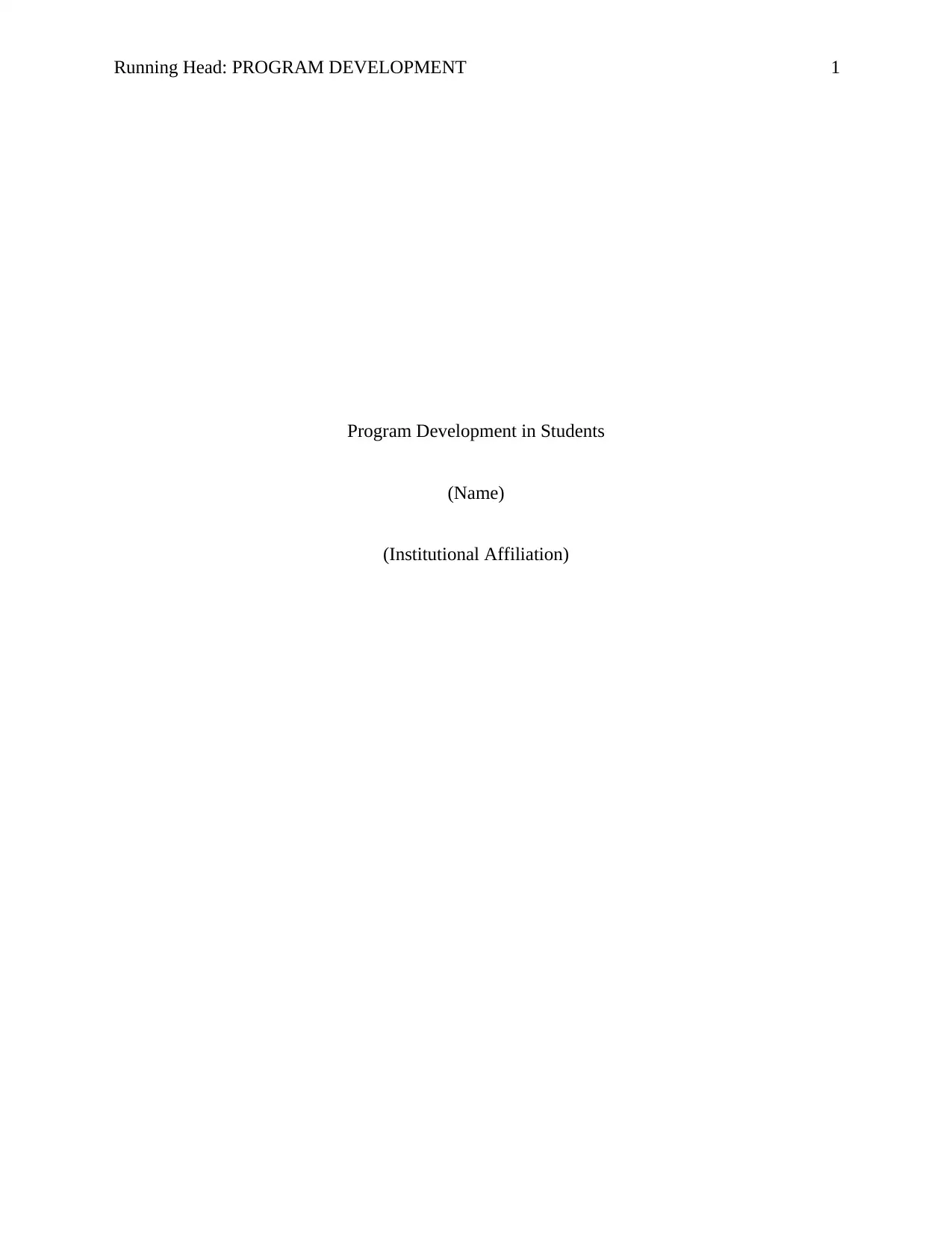
Running Head: PROGRAM DEVELOPMENT 1
Program Development in Students
(Name)
(Institutional Affiliation)
Program Development in Students
(Name)
(Institutional Affiliation)
Secure Best Marks with AI Grader
Need help grading? Try our AI Grader for instant feedback on your assignments.
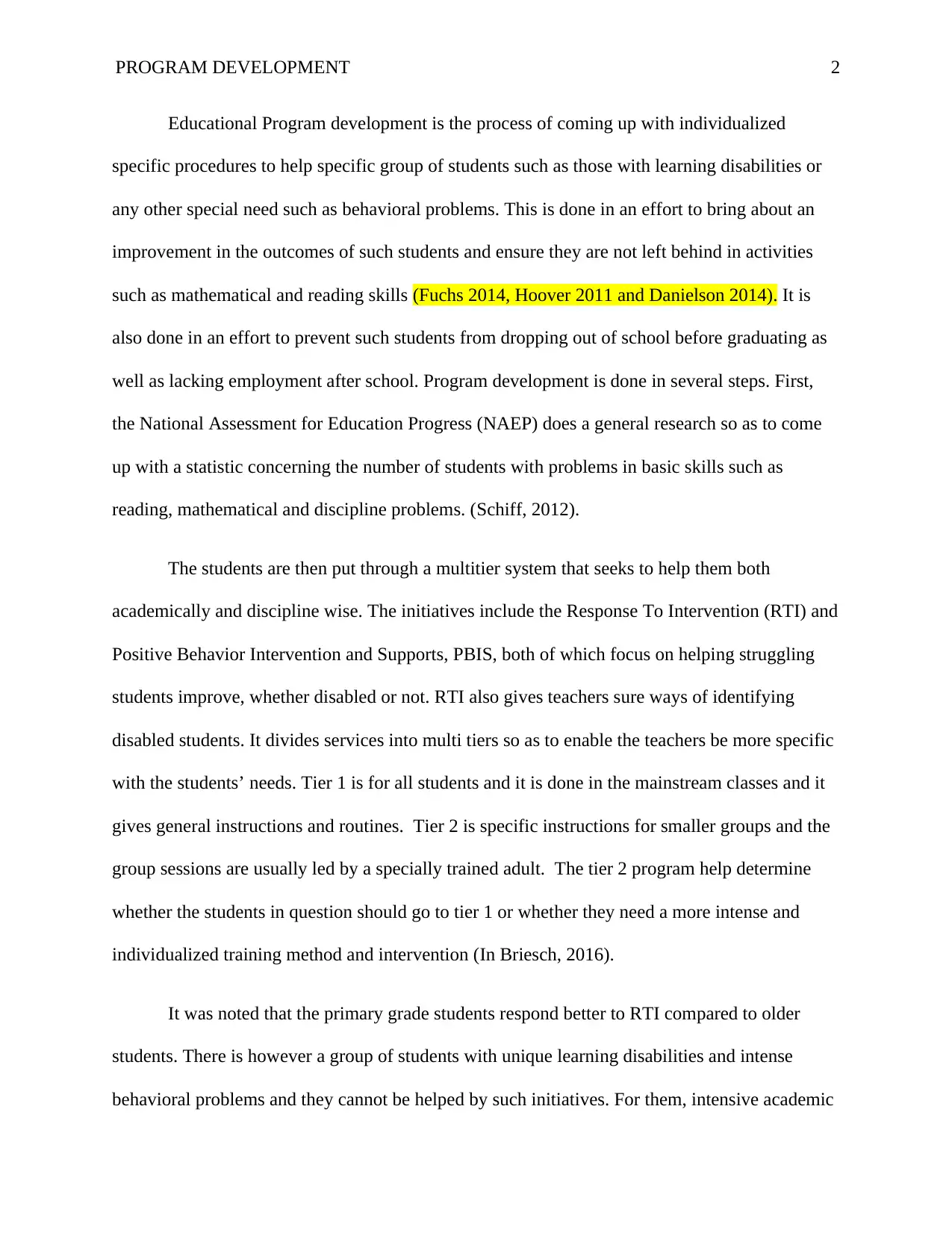
PROGRAM DEVELOPMENT 2
Educational Program development is the process of coming up with individualized
specific procedures to help specific group of students such as those with learning disabilities or
any other special need such as behavioral problems. This is done in an effort to bring about an
improvement in the outcomes of such students and ensure they are not left behind in activities
such as mathematical and reading skills (Fuchs 2014, Hoover 2011 and Danielson 2014). It is
also done in an effort to prevent such students from dropping out of school before graduating as
well as lacking employment after school. Program development is done in several steps. First,
the National Assessment for Education Progress (NAEP) does a general research so as to come
up with a statistic concerning the number of students with problems in basic skills such as
reading, mathematical and discipline problems. (Schiff, 2012).
The students are then put through a multitier system that seeks to help them both
academically and discipline wise. The initiatives include the Response To Intervention (RTI) and
Positive Behavior Intervention and Supports, PBIS, both of which focus on helping struggling
students improve, whether disabled or not. RTI also gives teachers sure ways of identifying
disabled students. It divides services into multi tiers so as to enable the teachers be more specific
with the students’ needs. Tier 1 is for all students and it is done in the mainstream classes and it
gives general instructions and routines. Tier 2 is specific instructions for smaller groups and the
group sessions are usually led by a specially trained adult. The tier 2 program help determine
whether the students in question should go to tier 1 or whether they need a more intense and
individualized training method and intervention (In Briesch, 2016).
It was noted that the primary grade students respond better to RTI compared to older
students. There is however a group of students with unique learning disabilities and intense
behavioral problems and they cannot be helped by such initiatives. For them, intensive academic
Educational Program development is the process of coming up with individualized
specific procedures to help specific group of students such as those with learning disabilities or
any other special need such as behavioral problems. This is done in an effort to bring about an
improvement in the outcomes of such students and ensure they are not left behind in activities
such as mathematical and reading skills (Fuchs 2014, Hoover 2011 and Danielson 2014). It is
also done in an effort to prevent such students from dropping out of school before graduating as
well as lacking employment after school. Program development is done in several steps. First,
the National Assessment for Education Progress (NAEP) does a general research so as to come
up with a statistic concerning the number of students with problems in basic skills such as
reading, mathematical and discipline problems. (Schiff, 2012).
The students are then put through a multitier system that seeks to help them both
academically and discipline wise. The initiatives include the Response To Intervention (RTI) and
Positive Behavior Intervention and Supports, PBIS, both of which focus on helping struggling
students improve, whether disabled or not. RTI also gives teachers sure ways of identifying
disabled students. It divides services into multi tiers so as to enable the teachers be more specific
with the students’ needs. Tier 1 is for all students and it is done in the mainstream classes and it
gives general instructions and routines. Tier 2 is specific instructions for smaller groups and the
group sessions are usually led by a specially trained adult. The tier 2 program help determine
whether the students in question should go to tier 1 or whether they need a more intense and
individualized training method and intervention (In Briesch, 2016).
It was noted that the primary grade students respond better to RTI compared to older
students. There is however a group of students with unique learning disabilities and intense
behavioral problems and they cannot be helped by such initiatives. For them, intensive academic
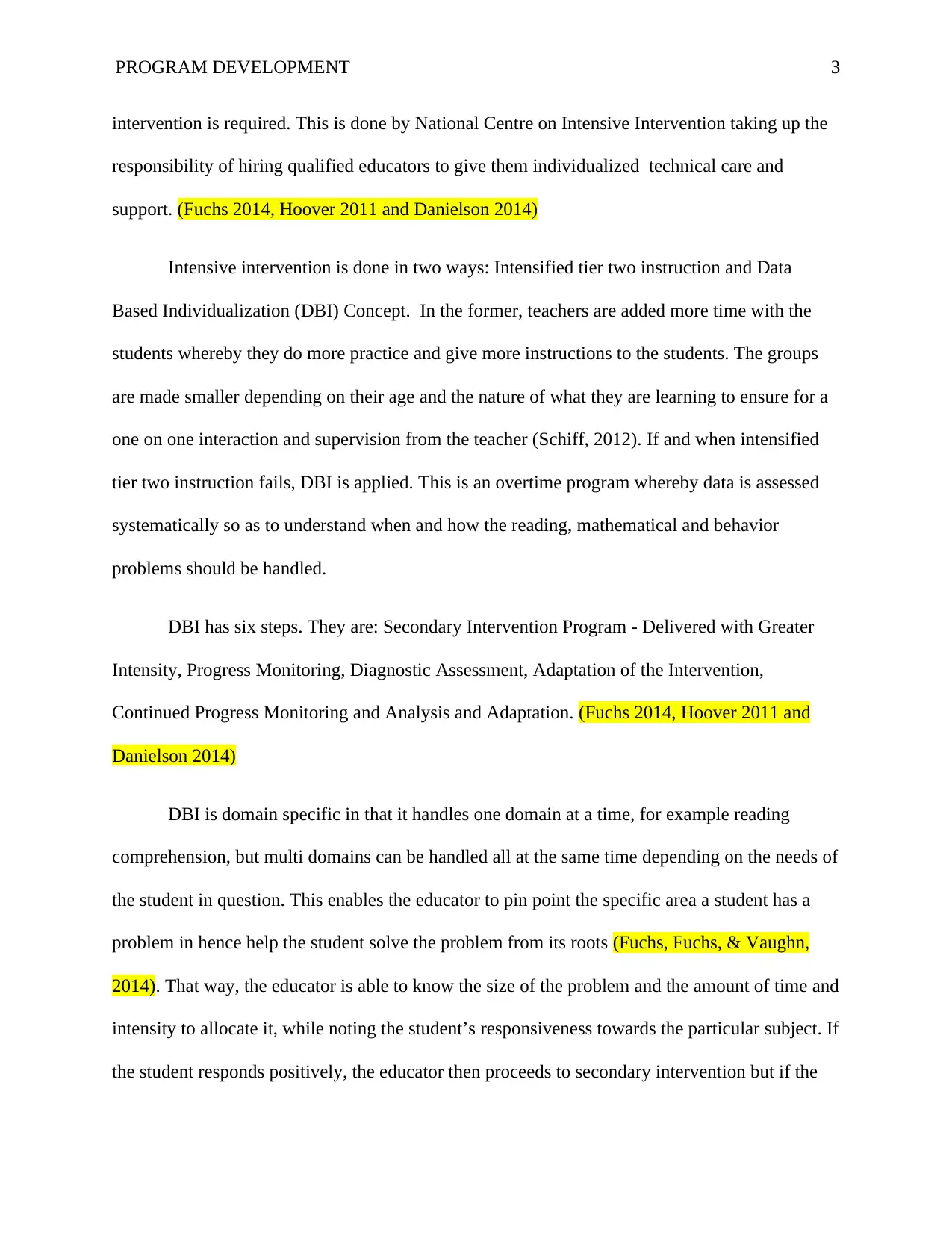
PROGRAM DEVELOPMENT 3
intervention is required. This is done by National Centre on Intensive Intervention taking up the
responsibility of hiring qualified educators to give them individualized technical care and
support. (Fuchs 2014, Hoover 2011 and Danielson 2014)
Intensive intervention is done in two ways: Intensified tier two instruction and Data
Based Individualization (DBI) Concept. In the former, teachers are added more time with the
students whereby they do more practice and give more instructions to the students. The groups
are made smaller depending on their age and the nature of what they are learning to ensure for a
one on one interaction and supervision from the teacher (Schiff, 2012). If and when intensified
tier two instruction fails, DBI is applied. This is an overtime program whereby data is assessed
systematically so as to understand when and how the reading, mathematical and behavior
problems should be handled.
DBI has six steps. They are: Secondary Intervention Program - Delivered with Greater
Intensity, Progress Monitoring, Diagnostic Assessment, Adaptation of the Intervention,
Continued Progress Monitoring and Analysis and Adaptation. (Fuchs 2014, Hoover 2011 and
Danielson 2014)
DBI is domain specific in that it handles one domain at a time, for example reading
comprehension, but multi domains can be handled all at the same time depending on the needs of
the student in question. This enables the educator to pin point the specific area a student has a
problem in hence help the student solve the problem from its roots (Fuchs, Fuchs, & Vaughn,
2014). That way, the educator is able to know the size of the problem and the amount of time and
intensity to allocate it, while noting the student’s responsiveness towards the particular subject. If
the student responds positively, the educator then proceeds to secondary intervention but if the
intervention is required. This is done by National Centre on Intensive Intervention taking up the
responsibility of hiring qualified educators to give them individualized technical care and
support. (Fuchs 2014, Hoover 2011 and Danielson 2014)
Intensive intervention is done in two ways: Intensified tier two instruction and Data
Based Individualization (DBI) Concept. In the former, teachers are added more time with the
students whereby they do more practice and give more instructions to the students. The groups
are made smaller depending on their age and the nature of what they are learning to ensure for a
one on one interaction and supervision from the teacher (Schiff, 2012). If and when intensified
tier two instruction fails, DBI is applied. This is an overtime program whereby data is assessed
systematically so as to understand when and how the reading, mathematical and behavior
problems should be handled.
DBI has six steps. They are: Secondary Intervention Program - Delivered with Greater
Intensity, Progress Monitoring, Diagnostic Assessment, Adaptation of the Intervention,
Continued Progress Monitoring and Analysis and Adaptation. (Fuchs 2014, Hoover 2011 and
Danielson 2014)
DBI is domain specific in that it handles one domain at a time, for example reading
comprehension, but multi domains can be handled all at the same time depending on the needs of
the student in question. This enables the educator to pin point the specific area a student has a
problem in hence help the student solve the problem from its roots (Fuchs, Fuchs, & Vaughn,
2014). That way, the educator is able to know the size of the problem and the amount of time and
intensity to allocate it, while noting the student’s responsiveness towards the particular subject. If
the student responds positively, the educator then proceeds to secondary intervention but if the
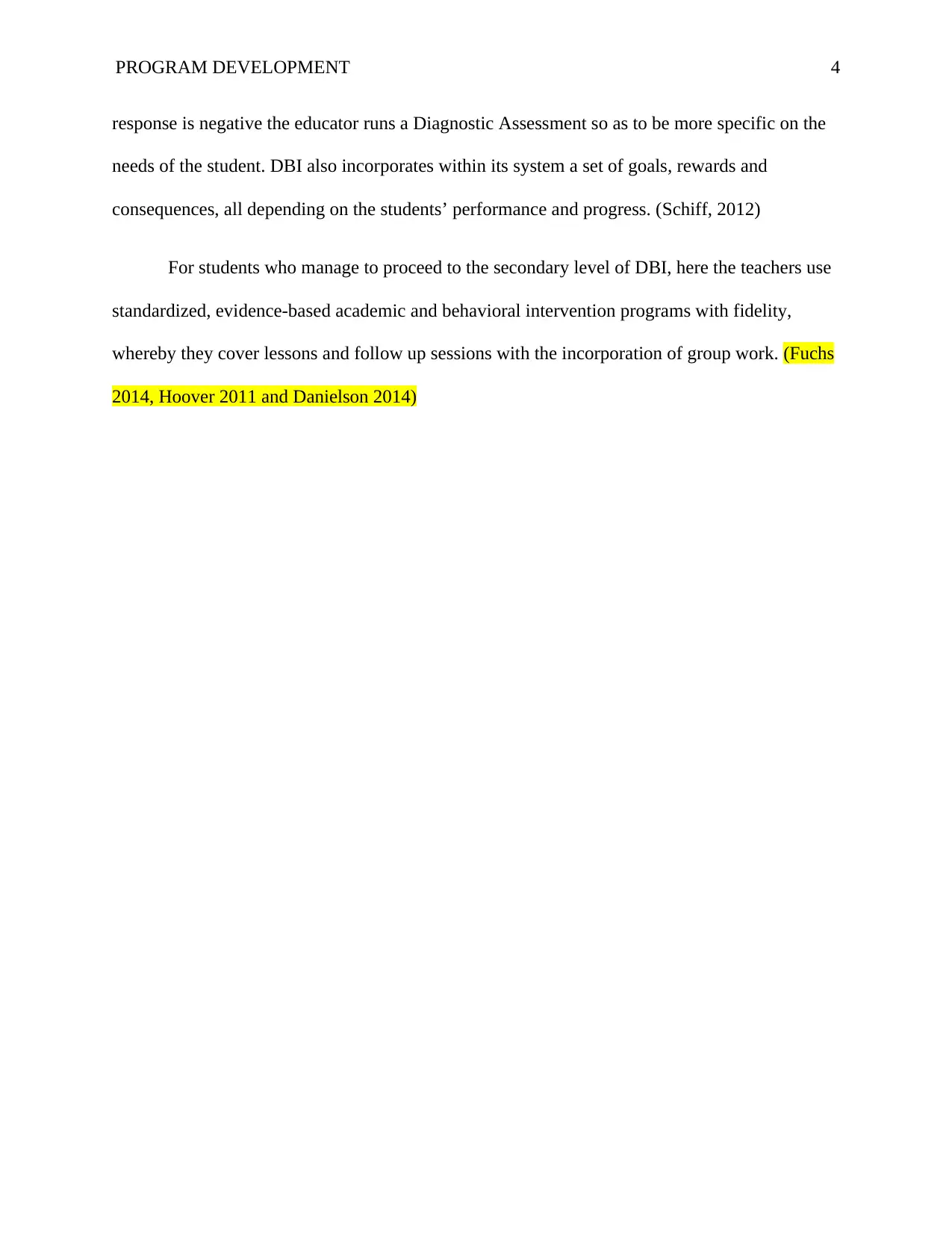
PROGRAM DEVELOPMENT 4
response is negative the educator runs a Diagnostic Assessment so as to be more specific on the
needs of the student. DBI also incorporates within its system a set of goals, rewards and
consequences, all depending on the students’ performance and progress. (Schiff, 2012)
For students who manage to proceed to the secondary level of DBI, here the teachers use
standardized, evidence-based academic and behavioral intervention programs with fidelity,
whereby they cover lessons and follow up sessions with the incorporation of group work. (Fuchs
2014, Hoover 2011 and Danielson 2014)
response is negative the educator runs a Diagnostic Assessment so as to be more specific on the
needs of the student. DBI also incorporates within its system a set of goals, rewards and
consequences, all depending on the students’ performance and progress. (Schiff, 2012)
For students who manage to proceed to the secondary level of DBI, here the teachers use
standardized, evidence-based academic and behavioral intervention programs with fidelity,
whereby they cover lessons and follow up sessions with the incorporation of group work. (Fuchs
2014, Hoover 2011 and Danielson 2014)
Secure Best Marks with AI Grader
Need help grading? Try our AI Grader for instant feedback on your assignments.
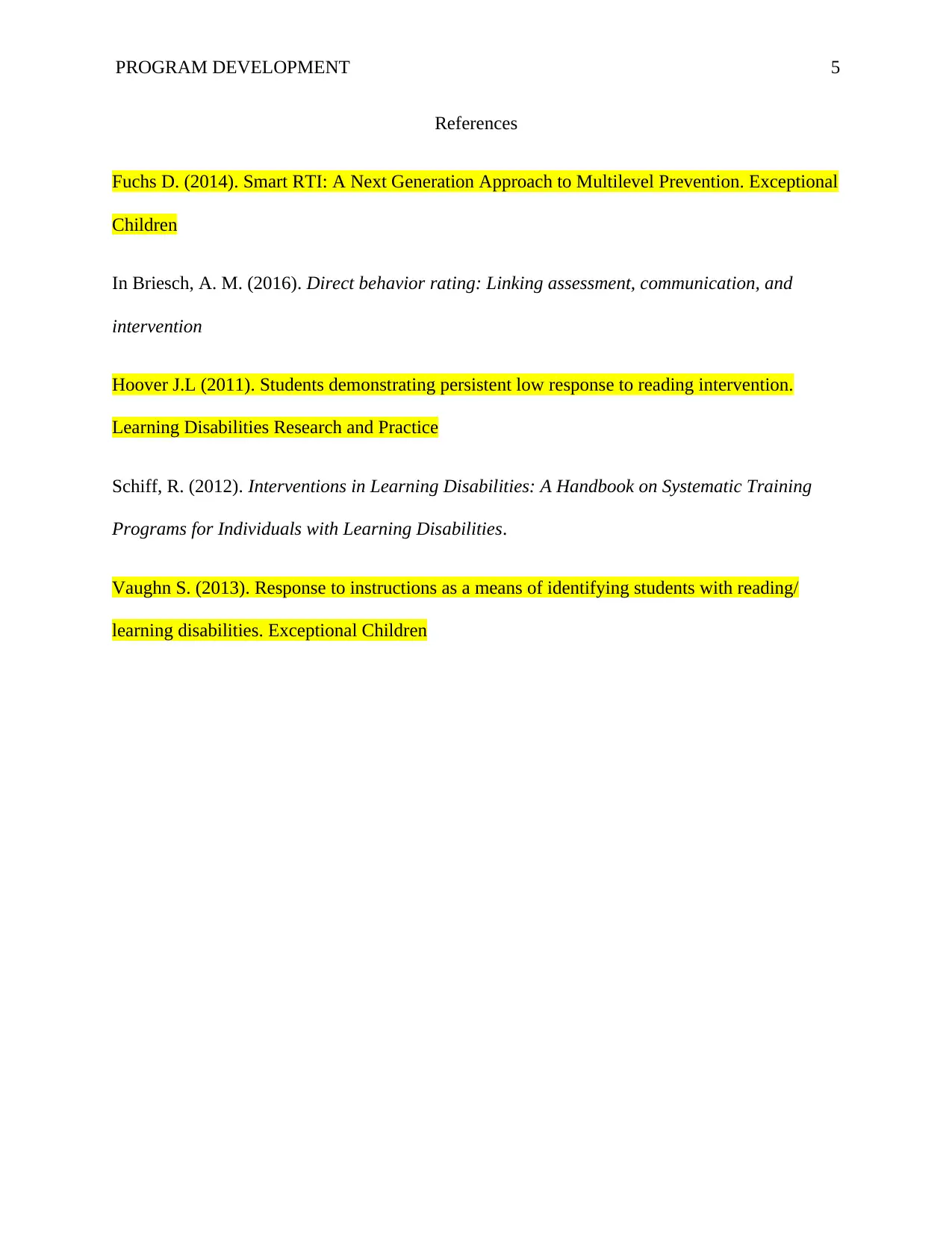
PROGRAM DEVELOPMENT 5
References
Fuchs D. (2014). Smart RTI: A Next Generation Approach to Multilevel Prevention. Exceptional
Children
In Briesch, A. M. (2016). Direct behavior rating: Linking assessment, communication, and
intervention
Hoover J.L (2011). Students demonstrating persistent low response to reading intervention.
Learning Disabilities Research and Practice
Schiff, R. (2012). Interventions in Learning Disabilities: A Handbook on Systematic Training
Programs for Individuals with Learning Disabilities.
Vaughn S. (2013). Response to instructions as a means of identifying students with reading/
learning disabilities. Exceptional Children
References
Fuchs D. (2014). Smart RTI: A Next Generation Approach to Multilevel Prevention. Exceptional
Children
In Briesch, A. M. (2016). Direct behavior rating: Linking assessment, communication, and
intervention
Hoover J.L (2011). Students demonstrating persistent low response to reading intervention.
Learning Disabilities Research and Practice
Schiff, R. (2012). Interventions in Learning Disabilities: A Handbook on Systematic Training
Programs for Individuals with Learning Disabilities.
Vaughn S. (2013). Response to instructions as a means of identifying students with reading/
learning disabilities. Exceptional Children
1 out of 5
Your All-in-One AI-Powered Toolkit for Academic Success.
+13062052269
info@desklib.com
Available 24*7 on WhatsApp / Email
![[object Object]](/_next/static/media/star-bottom.7253800d.svg)
Unlock your academic potential
© 2024 | Zucol Services PVT LTD | All rights reserved.